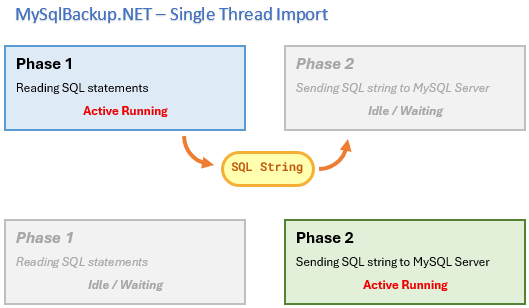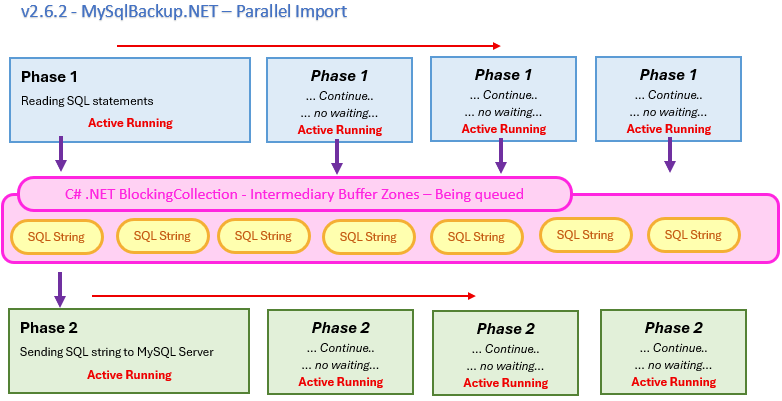-
Notifications
You must be signed in to change notification settings - Fork 109
Understanding the Parallel Import Mechanism in MySqlBackup.NET v2.6.2
Date: July 12th, 2025
Tip: From a human perspective, there's virtually no noticeable performance difference between the different import methods.
Note: Start from v2.6,2, MySqlBackup.NET is running import in parallel mode by default.
using (var conn = new MySqlConnection(constr))
using (var cmd = conn.CreateCommand())
using (var mb = new MySqlBackup(cmd))
{
conn.Open();
// enabled by default in 2.6, turn off this to run in legacy single thread
mb.ImportInfo.EnableParallelProcessing = true;
mb.ImportFromFile(@"C:\backup.sql");
}Here's the illustration diagram:


| Method | Batch Test 1 | Batch Test 2 | Average |
|---|---|---|---|
| MySqlBackup.NET Import Single Thread |
66s 162ms 69s 610ms 70s 153ms |
66s 387ms 70s 188ms 70s 137ms |
68s 773ms |
| MySqlBackup.NET Import Parallel |
64s 063ms 64s 094ms 64s 469ms |
65s 469ms 66s 141ms 65s 844ms |
65s 013ms |
| mysql.exe | 64s 625ms 62s 619ms 63s 016ms |
66s 922ms 64s 516ms 64s 655ms |
64s 392ms |
Date Report : July 12th, 2025
MySQL Community Server : 8.4.5
InnoDB Tables : 5
Total Rows : 685,000 rows
Database Size : 680 MB
SQL Dump Size : 978 MB (1.02 GB)
Server Throughput : 15.19 MB/sec, 10,637 rows/sec
Performance Results
mysql.exe : 64.4s
MySqlBackup.NET Parallel : 65.0s (+0.9%)
MySqlBackup.NET Standard : 68.8s (+6.8%)
While the benchmarking results show measurable differences between the three import methods, these variations are not significant enough to constitute meaningful performance improvements in real-world application contexts. The entire import process has already reached the bottleneck at the MySQL server level, which consumes approximately 95% of the total execution time processing large batches of rows. The marginal performance differences demonstrate that MySqlBackup.NET has already achieved optimal performance characteristics, making further optimization of the import process essentially meaningless since the constraint lies in the database server's inherent processing capabilities rather than the client-side import library implementation.